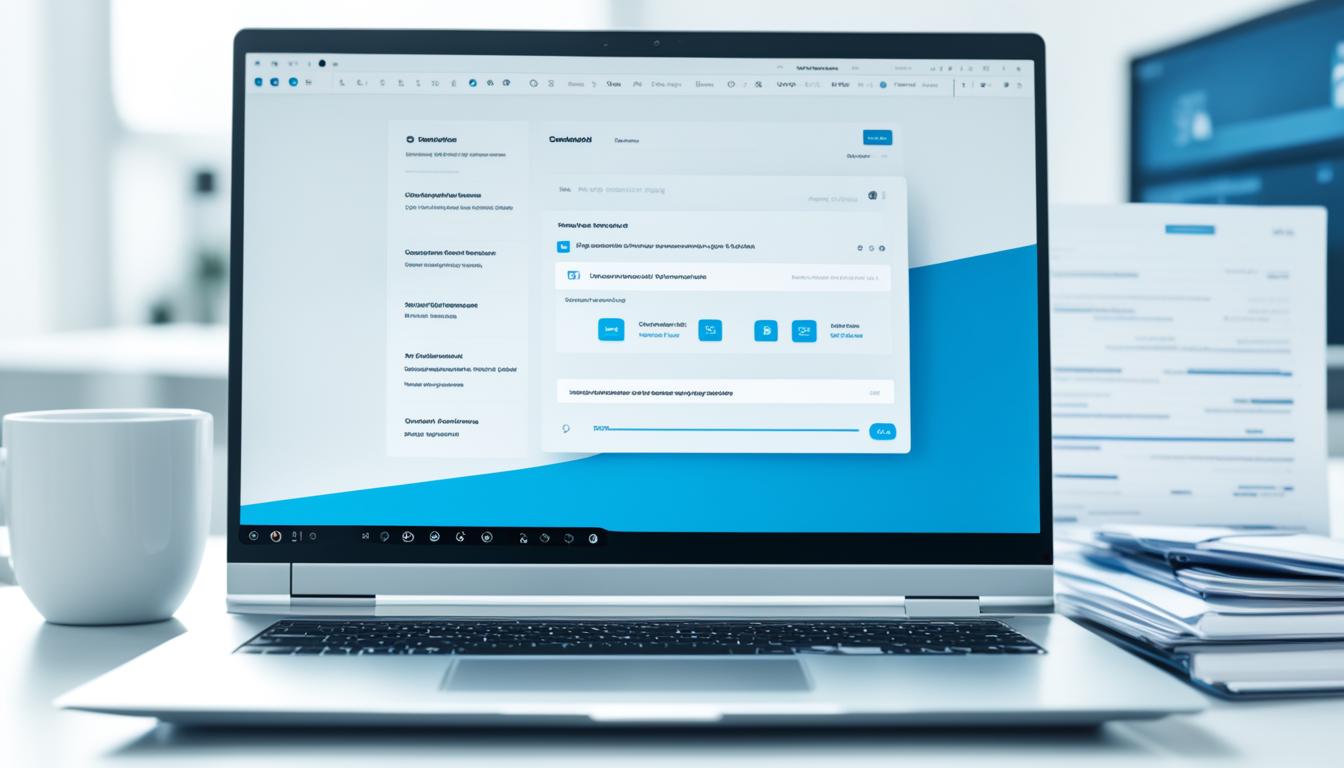What is an email domain and how to choose one
When it comes to setting up an email address, many people overlook the importance of choosing a domain that aligns with their personal or business brand. However, the email domain you choose plays a crucial role in how your recipients perceive you and can even affect your credibility and professionalism.
In this article, I will explain what an email domain is and provide you with valuable insights into how to choose the best email domain for your needs. Whether you’re an individual looking to establish a personal brand or a business seeking a professional email address, understanding the intricacies of email domain selection will help you make the right choice.
Key Takeaways:
- Your email domain is the part of your email address that comes after the @ symbol.
- Choosing the right email domain is crucial for establishing your online presence and credibility.
- Consider important factors such as support, cost-effectiveness, capabilities, coverage, and provider reputation when selecting an email domain.
- Mail.com offers over 100 free email domains to choose from, providing a wide range of options for customization.
- Owning a custom email domain offers benefits such as increased professionalism, brand recognition, and control over your email accounts.
Understanding Email Domains
An email domain is a crucial component of an email address. It is the unique identifier that follows the @ symbol. Just like a website domain helps identify the location of a website, an email domain serves a similar purpose for emails. It specifies the server associated with the domain and ensures that emails are delivered to the correct inbox.
Unlike the username part of an email address, which can be personalized, the email domain structure remains consistent. It typically consists of two parts: the domain name itself and the top-level domain (TLD). For example, in [email protected], “example” is the domain name, and “.com” is the TLD. The domain name is what makes an email address distinctive and reflects your brand or personal identity.
An email domain can have an unlimited number of email addresses associated with it. This allows you to create multiple email accounts using the same domain, making it easier to manage communications for different purposes or departments.
The purpose of email domains extends beyond identification. They play a crucial role in delivering emails securely and efficiently. By associating an email address with a specific domain, email servers can quickly route messages to the appropriate destination. This helps prevent emails from getting lost or misdirected, ensuring effective communication within organizations and between individuals.
| Email Domain Components | Description |
|---|---|
| Domain Name | The unique part of an email domain that identifies your brand or personal identity. |
| Top-Level Domain (TLD) | The extension that follows the domain name, such as .com, .org, or .ca. |
| Email Account | An email address associated with a specific email domain. |
| Email Server | The server that handles incoming and outgoing emails for a particular email domain. |
Understanding email domains is essential for managing and customizing your email communications effectively. It allows you to establish a professional online presence, build trust with recipients, and ensure reliable email delivery. In the next section, I will explain how to acquire an email domain and the different options available to you.
How to Get an Email Domain
To get an email domain, you have two options. First, you can purchase a domain name from a domain registrar and register the name. This option allows you to have a customized website along with email addresses using your domain.
The second option is to sign up for a free email account with an email provider that offers a variety of unique email domains. This option is ideal for those who don’t need a website or prefer a quick and easy way to get a customized email address.

| Purchasing an Email Domain | Registering an Email Domain |
|---|---|
| Pros: | Pros: |
|
|
| Cons: | Cons: |
|
|
Tips for Choosing an Email Domain
When it comes to choosing an email domain, there are several factors to consider that can help you make the best decision for your needs. Here are some valuable tips to guide you in selecting the right email domain:
1. Qualities of an Email Domain Provider
One crucial aspect to focus on is the qualities of the email domain provider. Look for providers that offer excellent customer support, ensuring they are available to assist you whenever you need help. Helpful and responsive customer service can make a significant difference in ensuring a smooth experience with your email domain provider.
2. Free or Paid Email Domain
Decide whether you prefer a free email domain or if a paid subscription will better suit your needs. Free email domain providers are a popular choice for personal use or small businesses with limited budgets. However, if you require more advanced features, increased storage, or professional branding, a paid email domain subscription may be the better option.
3. Capabilities and Compatibilities
Consider the capabilities and compatibilities of the email domain provider. Ensure that the provider offers user-friendly email apps that align with your preferences and work seamlessly across devices. Additionally, check the storage options provided, as ample storage is essential for managing your emails effectively.
4. Provider Coverage
Check if the email domain provider operates in your desired country. It’s crucial to choose a provider with coverage in your region to ensure reliable service and compliance with local regulations.
5. Reputation and Recommendations
Take the time to research the reputation of the email domain provider. Look for user reviews and recommendations to gain insights into the overall satisfaction of the provider’s customers. A reputable provider with positive reviews is more likely to offer a reliable email domain service.
By considering these tips, you can make an informed decision when selecting an email domain that meets your requirements and sets the foundation for successful communication.
Selecting a Mail.com Email Domain
If you’re looking for a customizable and professional email domain, Mail.com offers a range of options to suit your needs. With over 100 free email domains to choose from, you can create a custom email address that reflects your profession, business, or personal interests.
To select a Mail.com email domain, simply visit their website and browse through their list of 100+ domains. You’ll find domain options such as @consultant.com, @doctor.com, @engineer.com, and many more. Choose the domain that resonates with you and captures the essence of your email identity.
Once you have decided on a domain, you can quickly check the availability of the email address you desire. If it’s available, you can proceed to create an email account under that name. With a Mail.com account, you can even create and use up to 10 email addresses within a single account, giving you flexibility and convenience in managing your communication channels.

| Email Domain | Features |
|---|---|
| @consultant.com | Impress clients with a professional email domain that reflects your expertise. |
| @doctor.com | Establish credibility and trust in the healthcare industry. |
| @engineer.com | Showcase your technical skills and professionalism. |
The Difference Between an Email Domain and a Website Address
An email domain and a website address are two distinct components in the realm of online communication. While they both utilize domain names, they serve different purposes and function in separate contexts.
An email domain specifically refers to the part of an email address that follows the @ symbol. It acts as a unique identifier for email accounts, ensuring that messages reach the correct mail server. For example, in the email address “[email protected],” the domain is “example.com.”
On the other hand, a website address, also known as a URL, is used to access specific webpages. It plays a key role in locating and displaying web content. For instance, in the URL “www.example.com,” the domain name is “example.com.”
Although email domains and website addresses share the use of domain names, their purposes and functionalities diverge. Email domains primarily focus on facilitating the delivery of emails, ensuring that messages are directed to the appropriate mail server. In contrast, website addresses enable users to navigate and access webpages hosted on specific servers.
It’s worth noting that domain names, regardless of their usage in email domains or website addresses, simplify internet navigation for users. They are more user-friendly than IP addresses and allow individuals to browse the internet effortlessly.
Understanding the distinction between email domains and website addresses is essential for effective communication and web navigation. By recognizing the unique roles and functionalities of these components, users can optimize their online experiences and streamline their digital interactions.
Benefits of Owning an Email Domain
Owning a custom email domain offers several benefits. It adds professionalism to your email address, making your business look more legitimate and trustworthy. It helps build brand recognition and reinforces your brand identity in customer communications. Having your own email domain also gives you more control over your email accounts, allows for more advanced security measures, and distinguishes your business from competitors who use free email services. Additionally, a custom email domain can enhance your credibility and professionalism in the eyes of clients or customers.
| Benefits of Owning an Email Domain |
|---|
| Adds professionalism to your email address |
| Builds brand recognition and identity |
| Provides more control over email accounts |
| Allows for advanced security measures |
| Distinguishes your business from competitors |
| Enhances credibility and professionalism |
Setting Up an Email Domain
Setting up an email domain is an essential step in establishing a professional online presence for your business. Follow these steps to successfully configure your email domain and ensure smooth email operations.
- Purchase a domain name: Start by registering your desired domain name with a reputable domain registrar. Choose a name that reflects your brand and is easy for your customers to remember.
- Sign up for an email hosting service: Next, subscribe to an email hosting plan. You can either opt for an email hosting service offered by your domain registrar or choose a separate email hosting provider that meets your specific needs.
- Configure email address settings: Once you have your domain and hosting service in place, configure the necessary email address settings. This includes setting up email aliases, distribution lists, and forwarding rules to streamline your email management.
- Create mailboxes and configure email clients: Set up mailboxes for your email accounts, ensuring that each member of your team has a unique email address. Configure the email client software or application to connect to the email provider’s servers, allowing you to send and receive emails seamlessly.
- Test email sending and receiving: To ensure everything is working smoothly, test the email sending and receiving functionality. Send test emails to different recipients and confirm that they are delivered correctly.
- Add additional features and security settings: Enhance the functionality of your email domain by adding useful features such as email filters, autoresponders, and spam protection. Implement security measures like two-factor authentication and encryption to safeguard your sensitive communications.
- Maintain regular upkeep: Regularly monitor and maintain your email domain to ensure uninterrupted service. Keep an eye on storage limitations, renew your domain registration when necessary, and stay updated with the latest security patches and updates.
By following these steps and investing a little time and effort, you can successfully set up and configure your email domain, providing your business with a professional and reliable email communication platform.
FAQ
What is an email domain and how to choose one?
What is an email domain?
How can I get an email domain?
What should I consider when choosing an email domain?
How can I select a mail.com email domain?
What’s the difference between an email domain and a website address?
What are the benefits of owning an email domain?
How do I set up an email domain?
- How Strategic SEO Drove Growth for a CPAP E-commerce Brand - July 24, 2025
- Top 3 SEO Companies in Toronto: An Analytical Comparison - July 23, 2025
- SEO for Entry Door Services - April 24, 2025





















Post Comment
You must be logged in to post a comment.